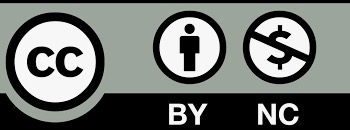Published
2022-02-10
Issue
Section
Research Articles
License
The journal adopts the Attribution-NonCommercial 4.0 International (CC BY-NC 4.0), which means that anyone can reuse and redistribute the materials for non-commercial purposes as long as you follow the license terms and the original source is properly cited.
Author(s) shall retain the copyright of their work and grant the Journal/Publisher rights for the first publication with the work concurrently licensed since 2023 Vol.8 No.2.
Under this license, author(s) will allow third parties to download, reuse, reprint, modify, distribute and/or copy the content under the condition that the authors are given credit. No permission is required from the authors or the publisher.
This broad license intends to facilitate free access, as well as the unrestricted use of original works of all types. This ensures that the published work is freely and openly available in perpetuity.
By providing open access, the following benefits are brought about:
- Higher Visibility, Availability and Citations-free and unlimited accessibility of the publication over the internet without any restrictions increases citation of the article.
- Ease of search-publications are easily searchable in search engines and indexing databases.
- Rapid Publication – accepted papers are immediately published online.
- Available for free download immediately after publication at https://esp.as-pub.com/index.php/ESP

Copyright Statement
1.The authors certify that the submitted manuscripts are original works, do not infringe the rights of others, are free from academic misconduct and confidentiality issues, and that there are no disputes over the authorship scheme of the collaborative articles. In case of infringement, academic misconduct and confidentiality issues, as well as disputes over the authorship scheme, all responsibilities will be borne by the authors.
2. The author agrees to grant the Editorial Office of Environment and Social Psychology a licence to use the reproduction right, distribution right, information network dissemination right, performance right, translation right, and compilation right of the submitted manuscript, including the work as a whole, as well as the diagrams, tables, abstracts, and any other parts that can be extracted from the work and used in accordance with the characteristics of the journal. The Editorial Board of Environment and Social Psychology has the right to use and sub-licence the above mentioned works for wide dissemination in print, electronic and online versions, and, in accordance with the characteristics of the periodical, for the period of legal protection of the property right of the copyright in the work, and for the territorial scope of the work throughout the world.
3. The authors are entitled to the copyright of their works under the relevant laws of Singapore, provided that they do not exercise their rights in a manner prejudicial to the interests of the Journal.
About Licence
Environment and Social Psychology is an open access journal and all published work is available under the Creative Commons Licence, Authors shall retain copyright of their work and grant the journal/publisher the right of first publication, and their work shall be licensed under the Attribution-NonCommercial 4.0 International (CC BY-NC 4.0).
Under this licence, the author grants permission to third parties to download, reuse, reprint, modify, distribute and/or copy the content with attribution to the author. No permission from the author or publisher is required.
This broad licence is intended to facilitate free access to and unrestricted use of original works of all kinds. This ensures that published works remain free and accessible in perpetuity. Submitted manuscripts, once accepted, are immediately available to the public and permanently accessible free of charge on the journal’s official website (https://esp.as-pub.com/index.php/ESP). Allowing users to read, download, copy, print, search for or link to the full text of the article, or use it for other legal purposes. However, the use of the work must retain the author's signature, be limited to non-commercial purposes, and not be interpretative.
Click to download <Agreement on the Licence for the Use of Copyright on Environmental and Social Psychology>.
How to Cite
Alcohol and Substance Use Disorders in Humanitarian Emergencies: Co-morbid Mental Disorders, Identifying Gaps and Emerging Trends
Oluwole Jegede
1 Interfaith Medical Center, Brooklyn, New York 2 George Washington University, Milken Institute School of Public Health Washington D. C
http://orcid.org/0000-0001-6772-7149
DOI: https://doi.org/10.18063/esp.v7.i1.684
Keywords: Substance use disorder, humanitarian emergencies, complex emergencies, alcohol abuse, mental illness
Abstract
The mental health needs of displaced persons have traditionally taken the backstage in the conceptualization of the overall medical treatment needs of this population. Despite the intuitive understanding that the trauma experienced by these individuals makes them particularly predisposed to mental illness and substance use disorders, there remains a dearth of scientific data to shed light on this all-important subject. Epidemiologic literature and data consistently fall short in describing the extent of this problem and in particular the attendant alcohol and substance abuse that not only afflict people in humanitarian contexts but also aid workers who attempt to lend a helping hand to these communities. There is little or no documentation on effective, and efficient ways to predict, diagnose and treat alcohol and substance use disorders among displaced persons living in humanitarian regions of the world. This paper describes themultidirectional nature of mental illness and substance abuse, the gaps in knowledge, as well as emerging trends particularly in diagnosis and treatment.Author Biography
Oluwole Jegede, 1 Interfaith Medical Center, Brooklyn, New York 2 George Washington University, Milken Institute School of Public Health Washington D. C
Resident Physician, Interfaith Medical Center, Brooklyn, New YorkReferences
[1]. American Psychiatric Association 2013; Diagnostic and statistical manual of mental disorders (DSM-5®). American Psychiatric Publishing.
[2]. Jones L, Asare JB, El Masri M, et al. Severe mental disorders in complex emergencies. The Lancet 2009; 374(9690): 654–661.
[3]. Ezard N. Substance use among populations displaced by conflict: A literature review. Disasters 2012; 36(3): 533-557.
[4]. Hanna FB. Alcohol and substance use in humanitarian and postconflict situations. Eastern Mediterranean Health Journal 2017; 23(3).
[5]. Bilak A. Global overview 2015: People internally displaced by conflict and violence. Internal Displacement Monitoring Centre. Norwegian Refugee Council 2015.
[6]. Lo J, Patel P, Shultz JM, et al. A systematic review on harmful alcohol use among civilian populations affected by armed conflict in low-and middle-income countries. Substance Use &
[7]. Misuse 2017; 52(11):1494-1510.
[8]. World Health Organization. (2016, April 5). Retrieved from
[9]. www.who.int/mediacentre/news/releases/2016/humanitarian-emergencies/en/.
[10]. Lai L. Treating substance abuse as a consequence of conflict and displacement: A call for a more inclusive global mental health. Medicine, conflict and survival 2014; 30(3): 182–189.
[11]. The Sphere Project. Humanitarian charter and minimum standards in humanitarian response. Practical Action Publishing 2011.
[12]. Patel V, Araya R, Chatterjee S, et al. Treatment and prevention of mental disorders in low-income and middle-income countries. The Lancet 2007; 370(9591): 991–1005.
[13]. Odenwald M, Neuner F, Schauer M, et al. Khat use as risk factor for psychotic disorders: A cross-sectional and case-control study in Somalia. BMC Medicine 2005; 3(1): 5.
[14]. Coldiron ME, Llosa AE, Roederer T, et al. Brief mental health interventions in conflict and emergency settings: An overview of four Médecins Sans Frontières–France programs. Conflict and health 2013; 7(1): 23.
[15]. World Health Organization. (2017). Retrieved from http://www.who.int/substance_abuse/facts/global_burden/en/
[16]. United Nations Office on Drugs and Crime. (2012). Retrieved from https://www.unodc.org/documents/dataandanalysis/WDR2012/WDR_2012_web_mall.pdf
[17]. Kozariæ-Kovaèiæ D, Ljubin T, Grappe M. Comorbidity of posttraumatic stress disorder and alcohol dependence in displaced persons. Croatian Medical Journal 2000; 41(2): 173– 178.
[18]. Harris BL, Levey EJ, Borba CP, et al. Substance use behaviors of secondary school students in post-conflict Liberia: A pilot study. International Journal of Culture and Mental Health2012; 5(3): 190–192.
[19]. Thabet AA, Vostanis P. Substance use among university students in the Gaza Strip. Arab
[20]. Journal of Psychiatry 2007; 18(1): 10–20.
[21]. Luitel NP, Jordans M, Murphy A, et al. Prevalence and patterns of hazardous and harmful
[22]. alcohol consumption assessed using the AUDIT among Bhutanese refugees in Nepal. Alcohol and Alcoholism 2013; 48(3): 349–355.
[23]. Nassan M, Frye MA, Adi A, et al. Telepsychiatry for post-traumatic stress disorder: A call for action in the Syrian conflict. The Lancet Psychiatry 2015; 2(10): 866.
[24]. Ursano RJ, Bell C, Eth S, et al. Practice guideline for the treatment of patients with acute stress disorder and posttraumatic stress disorder. Am J Psychiatry 2004; 161 (11 Suppl): 3–31.
[25]. Weathers FW, Litz BT, Herman DS, et al. The PTSD Checklist (PCL): Reliability, validity, and diagnostic utility. Annual convention of the international society for traumatic stress studies. San Antonio1993.
[26]. Stein MB, Sareen J. The American Psychiatric Publishing Textbook of Psychiatry, Anxiety Disorders (6 ed.). (R. Hales, S. C. Yudofsky, & W. Roberts L, Eds.) Airlington, VA: American Psychiatric Publishing 2014.
[27]. Reus VI, Fochtmann LJ, Bukstein O, et al. The American Psychiatric Association Practice
[28]. Guideline for the Pharmacological Treatment of Patients with Alcohol Use Disorder. American Journal of Psychiatry2017; 175(1): 86–90.
[29]. WHO. (2018). IASC Guidelines on Mental health and Psychosocial support in emergency settings. Retrieved from http://www.who.int/hac/network/interagency/news/mental_health_guidelines/en/
[30]. Rollman BL, Belnap BH, Abebe KZ, et al. Effectiveness of online collaborative care for treating mood and anxiety disorders in primary care: A randomized clinical trial. JAMA Psychiatry 2018; 75(1): 56–64.







